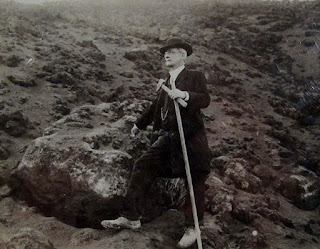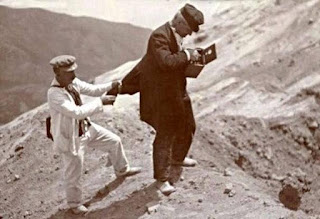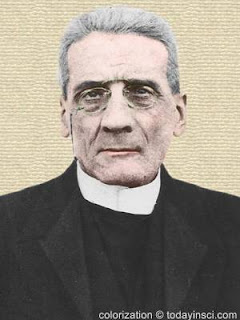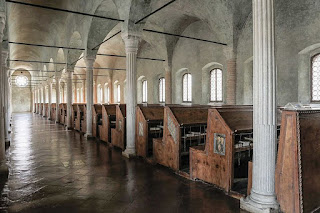 |
Giuseppe Mercalli became southern Europe's biggest
authority on earthquakes and volcanic activity |
Scientist who invented Mercalli Scale died in fire
The seismologist and volcanologist Giuseppe Mercalli, who at the time of his death was director of the Vesuvius Observatory, died in a fire at his home in Naples on this day in 1914.
The initial suspicion was that Mercalli, who devised a scale for determining the strength of earthquakes according to the intensity of shaking, had knocked over a paraffin lamp accidentally after falling asleep while working late.
However, an examination of his remains suggested by may have been strangled after disturbing an intruder, who then soaked his clothes in petrol before setting light to them. A sum of money worth the equivalent of $1,400 (€1,250) today was missing, although no one was ever apprehended for the crime.
Born in Milan, Mercalli was ordained a Roman Catholic priest and became a professor of Natural Sciences at the seminary of Milan, although he left under something of a cloud because of his support for
Antonio Rosmini, a controversial priest and philosopher who campaigned for social justice and was fiercely critical of various aspects of how the Roman Catholic church operated.
 |
Mercalli collecting data on the edge of the crater of Vesuvius,
with an aide on hand to keep him from falling |
After he had left, the Italian government appointed him a professor at Domodossola in Piedmont, followed by a post at Reggio di Calabria. He was professor of geology at the University of Catania in the late 1880s and was given a post at the Naples University in 1892. He became director of the Vesuvius Observatory in 1911.
He is best remembered for the Mercalli intensity scale for measuring earthquakes which, in modified form, is still used today.
While studying seismic activity in Italy in the late 19th century, Mercalli’s access to seismic instrumentation was limited. Most of Mercalli's information came from personal accounts and observations of damage. To provide consistency in his analyses, he decided he needed a way to measure the relative effects of each event.
He first developed a scale with six degrees, with the most disastrous earthquakes given an intensity of six, but felt that this did not provide enough precision. Another intensity scale called the deRossi-Forel scale that was gaining in prominence at the same time had the advantage of 10 degrees of intensity, although Mercalli felt it lacked meaningful description.
 |
Mercalli was ordained as a priest before
beginning his scientific career |
In 1902, Mercalli modified this 10-degree scale to include the detail he desired, and his new scale quickly caught on among European scientists
Mercalli also observed eruptions of the volcanoes
Stromboli and
Vulcano in the Aeolian Islands and his descriptions of these eruptions became the basis for two indices in the Volcanic Explosivity Index: 1 - Strombolian eruption, and 2 - Vulcanian eruption.
The scale has been tweaked by various other seismologists but remains the basis for determining an earthquake’s intensity. It is now known as the Modified Mercalli Intensity Scale.
Mercalli also engaged in detailed cataloguing of Italian earthquakes, which enabled him to produce a book -
I vulcani e fénomeni vulcanici in Italia - which he used to assemble a clear picture of where most of the events happened.
Mercalli's work built his reputation across southern Europe, and he was often called upon to study events throughout the continent. He travelled to Spain in 1884 to examine the aftermath of the Andalusian earthquake, and in 1887 Mercalli was the lead investigator of the deadly event in
Imperia along the French and Italian Riviera.
He became famous even beyond scientific circles, to the extent that his death and the speculation over the circumstances was reported in the New York Times.
 |
Some fascinating buildings line Piazza Mercato in the
medieval heart of Domodossola |
Travel tip:
The name
Domodossola is familiar to many Italian children as a line - ‘D’ is for Domodossola - recited in learning the alphabet at school. It is, in fact, a very pleasant town in northern Piedmont, close to the border with Switzerland and the last town at the Italian end of the Simplon Pass and the Simplon railway tunnel. Domodossola has a charming medieval centre around the Piazza Mercato, which has a number of interesting buildings. The Collegiale Church of Santi Gervasio and Protasio is the town’s most important church, while just outside the town is the Sacro Monte Calvario, a Roman Catholic sanctuary that is a UNESCO World Heritage site. The Palazzo Silva in Piazza Chiossi houses a civic museum. The area is surrounded by outstanding Alpine countryside, which can be admired from a light railway linking Domodossola and Locarno in Switzerland.
Domodossola hotels by Booking.com
 |
The vast crater of Mount Vesuvius, which remains classified
as an active volcano despite being quiet since 1944 |
Travel tip:
The
Vesuvius Observatory today is part of the Mount Vesuvius National Park, which was created in 1955. The crater of the volcano itself is accessible to visitors, albeit by guided tour only, and there is a road to within 200 metres of it, but after that the ascent is on foot only. The crater is about 200 metres deep and has a maximum diameter of about 600 metres. The climb is said to be well worth it because the view takes in the entire coastline from the Gulf of Gaeta, some 84km (52 miles) to the north, to the Sorrento peninsula. Visitors can take the Naples-Sorrento line of the Circumvesuviana railway and get off at Ercolano station, from where a shuttle bus runs to the park. As well as the observatory, there is a museum, a visitor centre, a restaurant and a shop where you can buy Lacrima Christi del Vesuvio, the wine made from the grapes grown on the sloped of the volcano.






















